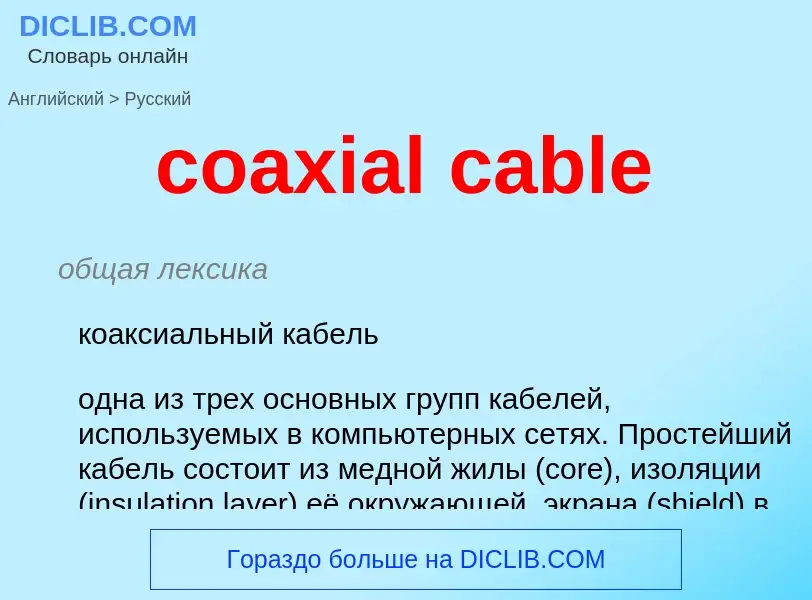Vertaling en analyse van woorden door kunstmatige intelligentie ChatGPT
Op deze pagina kunt u een gedetailleerde analyse krijgen van een woord of zin, geproduceerd met behulp van de beste kunstmatige intelligentietechnologie tot nu toe:
- hoe het woord wordt gebruikt
- gebruiksfrequentie
- het wordt vaker gebruikt in mondelinge of schriftelijke toespraken
- opties voor woordvertaling
- Gebruiksvoorbeelden (meerdere zinnen met vertaling)
- etymologie
coaxial cable - vertaling naar russisch
общая лексика
коаксиальный кабель
одна из трех основных групп кабелей, используемых в компьютерных сетях. Простейший кабель состоит из медной жилы (core), изоляции (insulation layer) её окружающей, экрана (shield) в виде металлической оплётки и внешней оболочки (т.е. проводники расположены концентрически, коаксиально. Отсюда и происходит название кабеля.). Существует два типа коаксиальных кабелей - с модулируемой и немодулируемой передачей, соответственно толстый (thick) и тонкий (thin) кабель. Тонкий имеет диаметр около 0,5 см, волновое сопротивление 50 Ом. Диаметр толстого кабеля около одного сантиметра, сопротивление 70 Ом
[kəuks]
общая лексика
коаксиальный кабель
сленговое сокращение термина
синоним
существительное
[kəuks]
общая лексика
человек, который умеет упросить, убедить
разговорное выражение
лиса
подлиза
льстивая
вкрадчивая речь
жаргонизм
пулемёт комплексной установки
глагол
общая лексика
уговаривать
задабривать
улещивать
добиваться (чего-л.) с помощью лести
уговоров
терпеливо добиваться (чего-л.)
упрашивать (лаской, терпеливо и т. п.), уговаривать
добиться чего-л. с помощью уговоров, лести
синоним
Wikipedia

Coaxial cable, or coax (pronounced ) is a type of electrical cable consisting of an inner conductor surrounded by a concentric conducting shield, with the two separated by a dielectric (insulating material); many coaxial cables also have a protective outer sheath or jacket. The term coaxial refers to the inner conductor and the outer shield sharing a geometric axis.
Coaxial cable is a type of transmission line, used to carry high-frequency electrical signals with low losses. It is used in such applications as telephone trunk lines, broadband internet networking cables, high-speed computer data busses, cable television signals, and connecting radio transmitters and receivers to their antennas. It differs from other shielded cables because the dimensions of the cable and connectors are controlled to give a precise, constant conductor spacing, which is needed for it to function efficiently as a transmission line.
Coaxial cable was used in the first (1858) and following transatlantic cable installations, but its theory was not described until 1880 by English physicist, engineer, and mathematician Oliver Heaviside, who patented the design in that year (British patent No. 1,407).





![High-end coaxial audio cable ([[S/PDIF]]) High-end coaxial audio cable ([[S/PDIF]])](https://commons.wikimedia.org/wiki/Special:FilePath/High-end-audio-cable-stereovox-HDXV.jpg?width=200)


![[[RG-6]] coaxial cable [[RG-6]] coaxial cable](https://commons.wikimedia.org/wiki/Special:FilePath/RG-6 coaxial cable.png?width=200)

![Semi-rigid coax installed in an [[Agilent]] N9344C 20GHz spectrum analyser Semi-rigid coax installed in an [[Agilent]] N9344C 20GHz spectrum analyser](https://commons.wikimedia.org/wiki/Special:FilePath/Semi-Rigid Coax Installed.jpg?width=200)
